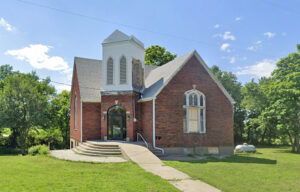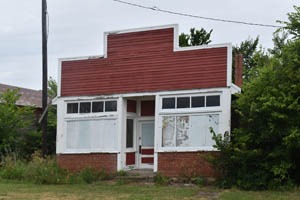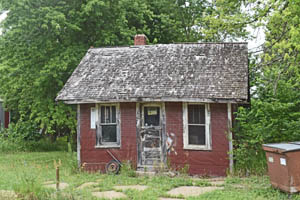
Vintage Fostoria, Kansas.
Fostoria, Kansas, is a ghost town in Pottawatomie County.
Located in Shannon Township, Fostoria probably started as a station on the Leavenworth, Kansas, and Western Railway, a branch of the Union Pacific Railroad. A post office was established on August 14, 1884.
The town grew slowly, and by 1910, it had a population of only 125. However, several businesses had been established, boasting a bank, a money order post office, a telegraph, and express offices.
In the following decades, the community remained small, and it continued to have a post office until the 1970s. However, the post office closed, and today, the community receives mail from nearby Ohlsburg.

Fostoria, Kansas buildings courtesy Google Maps.
The Blue Valley USD 384 public school district serves the community by providing Blue Valley High/Middle School in Randolph and McCormick Elementary School in Olsburg.
Today, this tiny community still has named streets, a few old business buildings, several homes, and an old Baptist Church.
Fostoria is located eight miles northwest of Westmoreland, the county seat, and six miles east of Olsburg.
©Kathy Alexander/Legends of Kansas, updated November 2024.
Readers Comments:
I was born in 1963, and my grandmother, Ercel King, was the Post Mistress. Around 1969, with the post office falling apart, they moved the mailboxes into the old bank building. My grandmother filled the vault with mail-order games and toys, added coolers for soft drinks, and delivered a few groceries from Westmoreland. There were church pews for benches where people would sit and talk. My grandmother walked from her house to the post office and back, put the flag up, took it down, and followed all the flag rules. She died in 1979. I don’t know exactly when she quit working, but I know she was still working in the summer of 1977. My uncles, Roy and George (and Lois) Stauffer, also lived in Fostoria. – Joy Antonio

Old Baptist Church in Fostoria, Kansas, courtesy of Google Maps.
Also See:
Extinct Towns in Pottawatomie County
Pottawatomie County Photo Gallery
Sources:
Blackmar, Frank W.; Kansas: A Cyclopedia of State History, Vol I; Standard Publishing Company, Chicago, IL 1912.
Wikipedia



